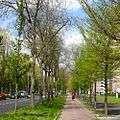Ulmus × hollandica 'Bea Schwarz'
The elm cultivar Ulmus × hollandica 'Bea Schwarz' was cloned (as No. 62) at Wageningen in the Netherlands, by the elm disease committee, ostensibly from a selection of Ulmus minor found in France in 1939. However, specimens of the tree grown in the UK and the United States are treated as Ulmus × hollandica (after Fontaine [1]).
| Ulmus × hollandica 'Bea Schwarz' | |
|---|---|
_040606c.jpg) 'Bea Schwarz', Amsterdam. | |
| Hybrid parentage | U. glabra × U. minor |
| Cultivar | 'Bea Schwarz' |
| Origin | Netherlands |
Description
The tree was considered of poor growth and shape.[2]
Pests and diseases
Moderately resistant to Dutch elm disease, and more resistant to Coral Spot fungus Nectria cinnabarina than its forebear 'Christine Buisman'.
Cultivation
Commercial production was discontinued soon after its release in 1948.[3][4][5] Nevertheless, its moderate resistance to Dutch elm disease saw it, or its selfed progeny, successfully used in later Dutch hybridizations, notably 'Nanguen' = Lutèce.
Notable trees
The largest known examples in the UK grow along Crespin Way, Hollingdean, Brighton; planted in 1964, they measured 19 m high by 50 cm d.b.h. in 2009.[7]
Hybrid cultivars
- 'Nanguen' = Lutèce, 'Clusius', 'Lobel', (all from crossings with 'Bea Schwarz' selfed), 'Amsterdam' (from an open pollination?).
Etymology
The tree is named for Bea Schwarz, the Dutch phytopathologist who identified Dutch elm disease in the 1920s.
Accessions
North America
- Arnold Arboretum, US. Acc. nos. 151–61, 276–62
- Holden Arboretum, US. Acc. no. 57–1243
- Longwood Gardens, US. Acc. no. 1967–0876
Europe
- Brighton & Hove City Council, UK. NCCPG Elm Collection.[8]
- Grange Farm Arboretum, Lincolnshire, UK. Acc. no. 1275
Nurseries
Europe
- Noordplant , Glimmen, Netherlands.
References
- F. J., Fontaine (1968). "Ulmus". Dendroflora. 5: 37–55. Retrieved 30 August 2017.
- Photograph of free-standing 'Bea Schwarz' elm, .
- Heybroek, Hans M. (1983). Burdekin, D.A. (ed.). "Resistant elms for Europe" (PDF). Forestry Commission Bulletin (Research on Dutch elm disease in Europe). London: HMSO (60): 108–113.
- Heybroek, H.M. (1993). "The Dutch Elm Breeding Program". In Sticklen, Mariam B.; Sherald, James L. (eds.). Dutch Elm Disease Research. New York, USA: Springer-Verlag. pp. 16–25. ISBN 978-1-4615-6874-2. Retrieved 26 October 2017.
- Went, J. C. (1954). Tijschr. Plantenziekten 60: 109-127, 1954.
- "Noordzijde near sloterplas". Noordzijde near sloterplas. Retrieved 21 February 2019.
- Johnson, O. (2011). Champion trees of Britain & Ireland, p.167. Kew Publishing, Kew London. ISBN 978-1-84246-452-6
- "List of plants in the {elm} collection". Brighton & Hove City Council. Retrieved 23 September 2016.
External links
- "Herbarium specimen - L.1586828". Botany catalogues. Naturalis Biodiversity Center. Sheet labelled Ulmus 'Bea Schwarz', Baarn, 1948
- "Herbarium specimen - L%20%200940206". Botany catalogues. Naturalis Biodiversity Center. Sheet labelled Ulmus 'Bea Schwarz', Baarn, 1949
- "Herbarium specimen DOV0038308". Delaware State University, Claude E. Phillips Herbarium. Sheet labelled U. × hollandica 'Bea Schwarz'; leaves specimen
- "Herbarium specimen DOV0038308". Delaware State University, Claude E. Phillips Herbarium. Sheet labelled U. × hollandica 'Bea Schwarz'; flowers specimen
